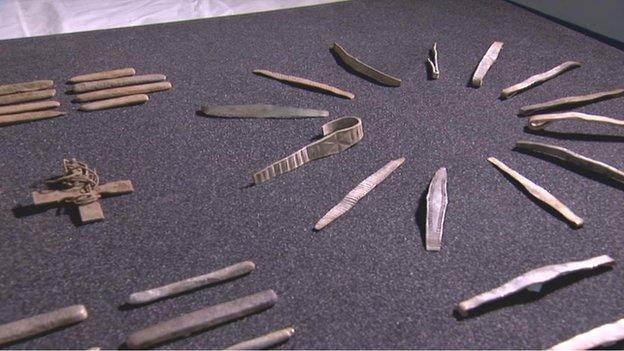Borders General Hospital X-ray reveals Viking pot's secrets
- Published

A hospital X-ray has helped to reveal the contents of a 9th Century bronze pot found in Dumfries and Galloway by an amateur with a metal detector.
The sealed vessel was part of a major Viking hoard found at an undisclosed location earlier this year.
It was considered too delicate to open so Historic Scotland teamed up with Borders General Hospital.
The £485,000 unit, normally used on patients, revealed brooches, ingots and beads inside.
Richard Welander, head of collections with Historic Scotland, said: "When I saw the results I was reminded of the words of Sir Howard Carter when Tutankhamen's tomb was opened in 1922 - "I see wonderful things".
"We are all so grateful to the Borders General Hospital for allowing us to forensically examine one of the key objects of the hoard.
"As with human patients, we need to investigate in a non-invasive way before moving onto delicate surgery.
"In this case, that will be the careful removal of the contents and the all-important conservation of these items."
Retired businessman Derek McLennan, 47, discovered the vessel among more than 100 artefacts on Church of Scotland land at an undisclosed site in Dumfries and Galloway.
When the find was made public by Scotland's Treasure Trove Unit last month, it was described as "one of the most significant Viking hoards ever discovered in Scotland".
But the small pot with a sealed lid fascinated experts who believed it contained more objects.
They knew from its ornate exterior that it hailed from the west European Carolingian period between 780 and 900 AD but had no idea what treasures it contained.
That is when Mr Welander made the call to Dr John Reid, consultant radiographer at Borders General Hospital, a keen amateur archaeologist and chairman of the Trimontium Trust in Melrose.
'Precious object'
He had previously used the CT (Computed Tomography) Scanner to supervise the scanning of the remains of a Roman soldier's head discovered at Trimontium, a former Roman camp near Melrose.
After obtaining permission from hospital chiefs, Dr Reid supervised the scanning of the pot.
He said: "The conservationists did not want to guddle about and compromise this precious object.
"I would like to assure people that this work takes place outwith normal hours and in no way impedes the important work we do for our human patients.
"The scanner is both rapid and accurate, with the ability to produce 120 visual slices and is accurate to within half a millimetre."
A short video of the pot being scanned at the hospital is currently available on YouTube, external under the title "Scanning Viking Hoard".
- Published12 October 2014
